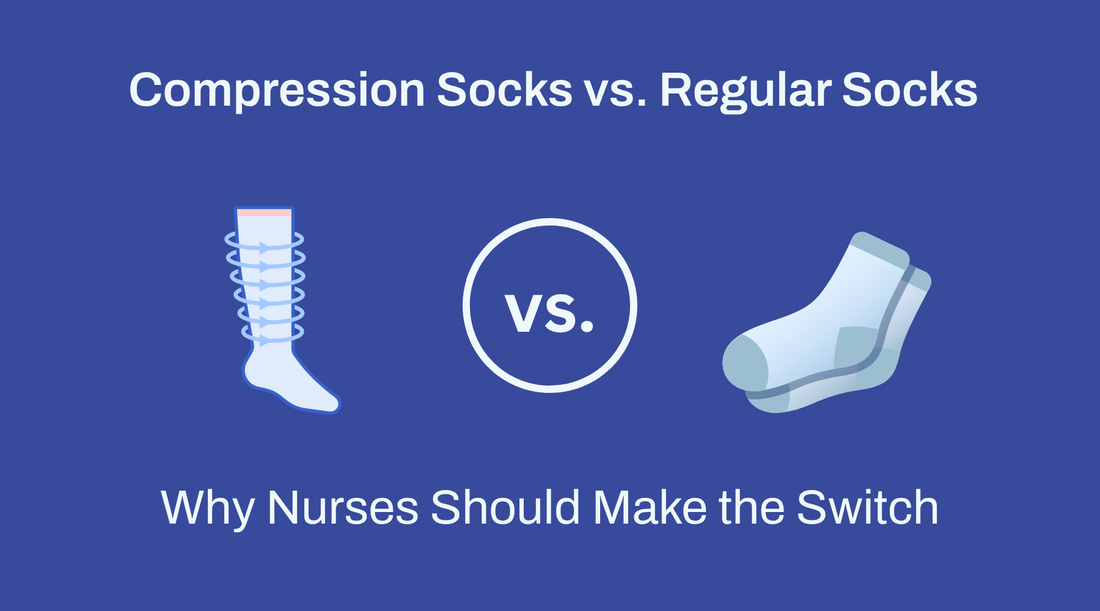
Compression Socks vs. Regular Socks: Why Nurses Should Make the Switch
From early mornings to double shifts, nurses log more steps in a day than most people do in a week. When you spend 10 to 12 hours on your feet, what you wear matters—down to the socks. While regular socks may be enough for everyday errands, they fall short in meeting the physical demands of nursing. That’s where nurse compression socks come in.
Understanding the difference between compression vs regular socks can help you make a choice that supports not just your feet, but your entire body. In this blog, Neotrek breaks down what sets nursing compression socks apart and why more nurses are making the switch.
The Core Differences: Compression vs Regular Socks
At a glance, compression socks and regular socks might seem similar—they cover your feet, fit inside your shoes, and come in different sizes. But beneath the surface, they serve entirely different functions.
Regular Socks:
- Designed primarily for coverage, comfort, or style
- Often made from cotton or basic blends
- Provide no targeted pressure or support
- Tend to lose shape and elasticity quickly with wear
Compression Socks:
- Engineered with graduated pressure, tighter at the ankle and looser toward the knee
- Made with performance fabrics designed to enhance circulation
- Reduce leg fatigue, swelling, and risk of vein issues
- Maintain structure and compression over time
When comparing compression vs regular socks, the key distinction is purpose. Regular socks are passive. Nurse compression socks are active—they’re a tool designed to support your health while you work.
Why Nurses Specifically Benefit from Compression Socks
Few professions put the same strain on the lower body as nursing. Constant standing, walking, and even stationary charting can contribute to poor circulation, swelling, and long-term vascular concerns.
Nursing compression socks offer targeted benefits:
- Improved Circulation: Graduated compression promotes venous return, reducing blood pooling in the lower extremities.
- Reduced Swelling: Keeps legs and ankles lean and less inflamed—even after long hours on your feet.
- Muscle Support: Compression stabilizes muscles, decreasing vibration and fatigue over time.
- Injury Prevention: Supports joints and tissues, potentially reducing the risk of shin splints, plantar fasciitis, and varicose veins.
Simply put, compression socks for nurses are preventive care built into your uniform. They help you feel better today—and protect your health for years to come.
Real-World Results: What Nurses Report
While the science is strong, it’s the firsthand experience that really speak volumes. Nurses who switch from regular socks to compression often report:
- Less end-of-day soreness
- More energy during and after shifts
- Reduced swelling, even after back-to-back shifts
- Better recovery between long workweeks
These results aren’t anecdotal flukes—they’re the expected outcome of better blood flow, muscle support, and material performance. Real nurse experiences confirm that those benefits only grow stronger during long shifts.
When Are Regular Socks Just Not Enough?
Regular socks may offer softness or style, but they lack the critical features needed for nursing environments. Cotton fibers trap moisture, which can lead to blisters and odor. Loose weaves offer no arch or calf support, and flat knits break down quickly under stress.
In contrast, nursing compression socks are built for performance:
- Moisture-Wicking Yarns: Keep feet dry in fast-paced conditions
- Seamless Construction: Reduces friction that causes blisters
- Durable Elasticity: Maintains compression even after repeated washes
- Reinforced Fit: Designed to stay in place and move with your body
- If your socks bunch, slide, or offer zero support by the end of a shift, it’s time to level up.
What to Look for in Nurse Compression Socks
Not all compression socks are created equal. For best results, choose the right socks for nursing that combine medical-grade function with nurse-ready design.
Key features to prioritize:
- Graduated Compression (15–20 mmHg): Ideal for everyday nursing use
- Knee-High Length: Offers full lower-leg support
- REPREVE® Performance Fabric: Eco-conscious, breathable, and moisture-wicking
- Durable Fit: Reinforced heel and arch support, with soft, non-restrictive cuffs
Unlike generic brands, Neotrek compression socks are purpose-built to balance style, structure, and sustainability—because support should never mean compromise.
Make the Switch. Protect Your Stride.
When comparing compression vs regular socks, the difference is more than technical—it's tangible. Compression socks actively support your health, enhance your performance, and improve how you feel during and after your shift.
Whether you're early in your career or decades in, nursing compression socks are a smart investment in your comfort, safety, and longevity.
Take the next step that will support every one of your steps. Explore Neotrek’s compression socks and feel the difference where it counts—on the job and beyond.